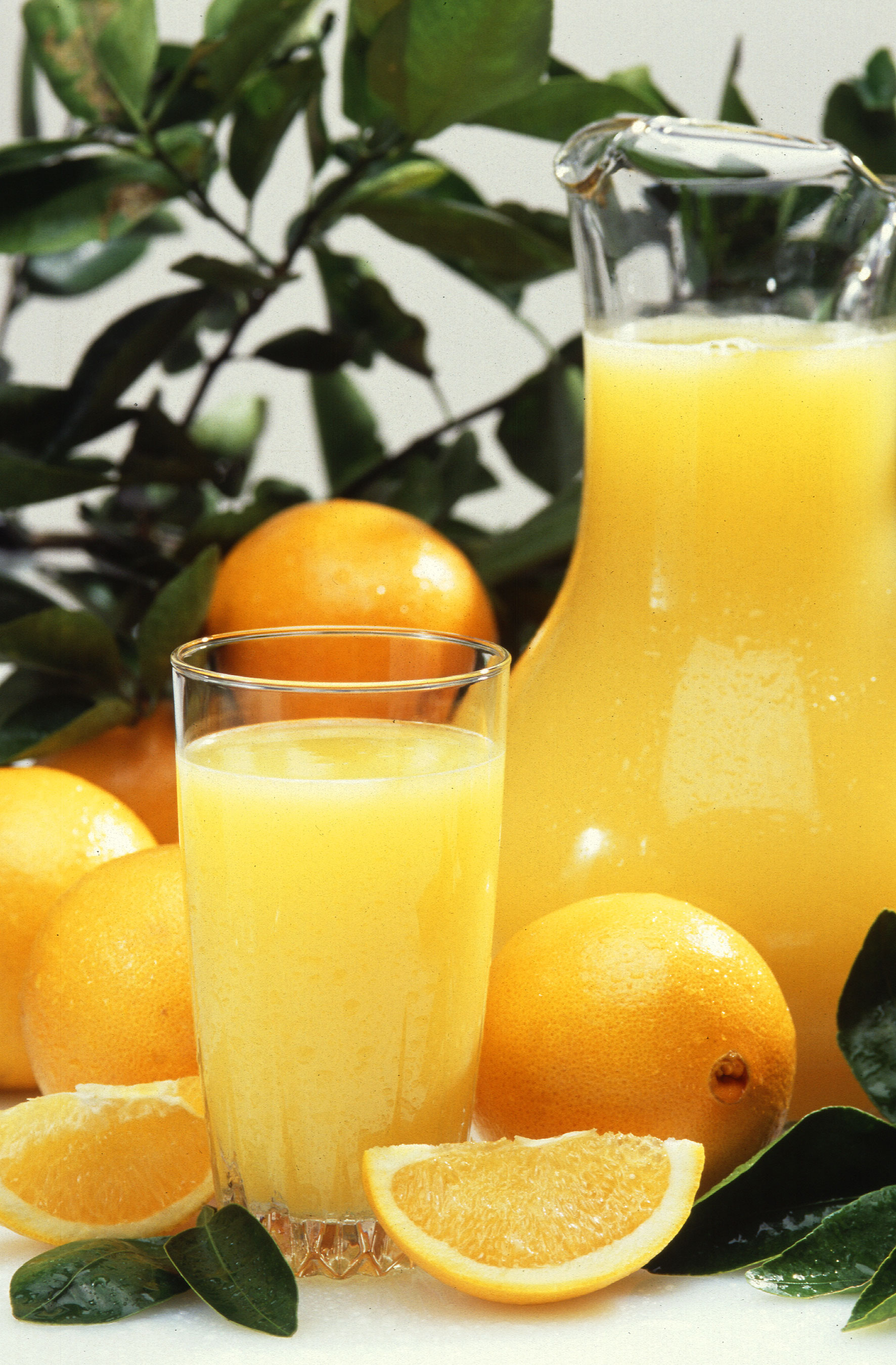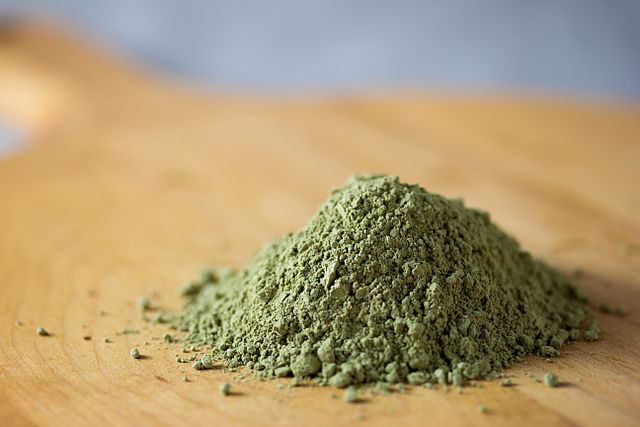Orange Juice vs. Tea Powder
Nutrition comparison of Orange Juice and Tea Powder
Ever wonder how your favorite foods stack up against each other in terms of nutrition?
We compared the nutritional contents of
orange juice
versus
tea powder
(100g each)
below using 2020 USDA and NIH data[1].
For a quick recap of significant nutrients and differences in orange juice and tea powder:
- Orange juice has more thiamin, however, tea powder contains more riboflavin, niacin, pantothenic acid, Vitamin B6 and folate.
- Orange juice is an excellent source of Vitamin C.
- Tea powder is a great source of iron.
- Tea powder is an excellent source of calcium, dietary fiber, potassium and protein.
USDA sources for nutritional information: Orange Juice (Orange juice, raw (Includes foods for USDA's Food Distribution Program)) and Tea Powder (Beverages, tea, instant, unsweetened, powder) . Have a correction or suggestions? Shoot us an email.
Calories and Carbs
calories
Tea powder is high in calories and orange juice has 86% less calories than tea powder - orange juice has 45 calories per 100 grams and tea powder has 315 calories.
For macronutrient ratios, orange juice is lighter in protein, heavier in carbs and heavier in fat compared to tea powder per calorie. Orange juice has a macronutrient ratio of 6:90:4 and for tea powder, 26:74:0 for protein, carbohydrates and fat from calories.
Macro Ratios from Calories:
| Orange Juice | Tea Powder | |
|---|---|---|
| Protein | 6% | 26% |
| Carbohydrates | 90% | 74% |
| Fat | 4% | ~ |
| Alcohol | ~ | ~ |
carbohydrates
Tea powder is high in carbohydrates and orange juice has 82% less carbohydrates than tea powder - orange juice has 10.4g of total carbs per 100 grams and tea powder has 58.7g of carbohydrates.
dietary fiber
Tea powder is an excellent source of dietary fiber and it has 41 times more dietary fiber than orange juice - orange juice has 0.2g of dietary fiber per 100 grams and tea powder has 8.5g of dietary fiber.
sugar
Orange juice and tea powder contain similar amounts of sugar - orange juice has 8.4g of sugar per 100 grams and tea powder has 5.5g of sugar.
Protein
protein
Tea powder is an excellent source of protein and it has 27 times more protein than orange juice - orange juice has 0.7g of protein per 100 grams and tea powder has 20.2g of protein.
Fat
saturated fat
Both orange juice and tea powder are low in saturated fat - orange juice has 0.02g of saturated fat per 100 grams and tea powder does not contain significant amounts.
Vitamins
Vitamin C
Orange juice is an excellent source of Vitamin C and it has more Vitamin C than tea powder - orange juice has 50mg of Vitamin C per 100 grams and tea powder does not contain significant amounts.
Vitamin A
Orange juice has more Vitamin A than tea powder - orange juice has 10ug of Vitamin A per 100 grams and tea powder does not contain significant amounts.
Vitamin E
Orange juice and tea powder contain similar amounts of Vitamin E - orange juice has 0.04mg of Vitamin E per 100 grams and tea powder does not contain significant amounts.
Vitamin K
Orange juice and tea powder contain similar amounts of Vitamin K - orange juice has 0.1ug of Vitamin K per 100 grams and tea powder does not contain significant amounts.
The B Vitamins
Orange juice has more thiamin, however, tea powder contains more riboflavin, niacin, pantothenic acid, Vitamin B6 and folate.
| Orange Juice | Tea Powder | |
|---|---|---|
| Thiamin | 0.09 MG | ~ |
| Riboflavin | 0.03 MG | 0.985 MG |
| Niacin | 0.4 MG | 10.8 MG |
| Pantothenic acid | 0.19 MG | 4.53 MG |
| Vitamin B6 | 0.04 MG | 0.356 MG |
| Folate | 30 UG | 103 UG |
Minerals
calcium
Tea powder is an excellent source of calcium and it has 973% more calcium than orange juice - orange juice has 11mg of calcium per 100 grams and tea powder has 118mg of calcium.
iron
Tea powder is a great source of iron and it has 10 times more iron than orange juice - orange juice has 0.2mg of iron per 100 grams and tea powder has 2.3mg of iron.
potassium
Tea powder is an excellent source of potassium and it has 29 times more potassium than orange juice - orange juice has 200mg of potassium per 100 grams and tea powder has 6040mg of potassium.
Omega-3 and Omega-6
omega 3s
For omega-3 fatty acids, tea powder has more alpha linoleic acid (ALA) than orange juice per 100 grams.
| Orange Juice | Tea Powder | |
|---|---|---|
| alpha linoleic acid | 0.011 G | 0.082 G |
| Total | 0.011 G | 0.082 G |
omega 6s
Comparing omega-6 fatty acids, both orange juice and tea powder contain small amounts of linoleic acid.
| Orange Juice | Tea Powder | |
|---|---|---|
| linoleic acid | 0.029 G | 0.04 G |
| Total | 0.029 G | 0.04 G |
Customize your serving size
The comparison below is by weight, but sometimes 100g isn't that intuitive of a measurement for food. View a custom portion comparison (e.g. cups, oz, package).
You can try adding or subtracting the amount of either Orange Juice or Tea Powder .
Note: The specific food items compared are: Orange Juice (Orange juice, raw (Includes foods for USDA's Food Distribution Program)) and Tea Powder (Beverages, tea, instant, unsweetened, powder) .
Orange Juice g
()
|
Daily Values (%) |
Tea Powder g
()
|
|||||
|---|---|---|---|---|---|---|---|
| KCAL % |
|
5% | calories | 5% |
|
KCAL % | |
| G % |
|
5% | carbohydrates | 5% |
|
G % | |
| G % |
|
5% | dietary fiber | 5% |
|
G % | |
| G | 5% | sugar | 5% | G | |||
| G % |
|
5% | total fat | 5% |
|
G % | |
| G % |
|
5% | saturated fat | 5% |
|
G % | |
| G | 5% | monounsaturated fat | 5% | G | |||
| G | 5% | polyunsaturated fat | 5% | G | |||
| G | 5% | trans fat | 5% | G | |||
| MG | 5% | cholesterol | 5% | MG | |||
| MG % |
|
5% | sodium | 5% |
|
MG % | |
| 5% | Vitamins and Minerals | 5% | |||||
| UG % |
|
5% | Vitamin A | 5% |
|
UG % | |
| MG % |
|
5% | Vitamin C | 5% |
|
MG % | |
| IU % |
|
5% | Vitamin D | 5% |
|
IU % | |
| MG % |
|
5% | calcium | 5% |
|
MG % | |
| MG % |
|
5% | iron | 5% |
|
MG % | |
| MG % |
|
5% | magnesium | 5% |
|
MG % | |
| MG % |
|
5% | potassium | 5% |
|
MG % | |
| MG % |
|
5% | thiamin (Vit B1) | 5% |
|
MG % | |
| MG % |
|
5% | riboflavin (Vit B2) | 5% |
|
MG % | |
| MG % |
|
5% | niacin (Vit B3) | 5% |
|
MG % | |
| MG % |
|
5% | Vitamin B6 | 5% |
|
MG % | |
| MG % |
|
5% | pantothenic acid (Vit B5) | 5% |
|
MG % | |
| UG % |
|
5% | folate (Vit B9) | 5% |
|
UG % | |
| UG % |
|
5% | Vitamin B12 | 5% |
|
UG % | |
| MG % |
|
5% | Vitamin E | 5% |
|
MG % | |
| UG % |
|
5% | Vitamin K | 5% |
|
UG % | |
| G % |
|
5% | protein | 5% |
|
G % | |
| UG % |
|
5% | biotin (Vit B7) | 5% |
|
UG % | |
| MG % |
|
5% | choline | 5% |
|
MG % | |
| MG % |
|
5% | chlorine | 5% |
|
MG % | |
| UG % |
|
5% | chromium | 5% |
|
UG % | |
| MG % |
|
5% | copper | 5% |
|
MG % | |
| UG % |
|
5% | fluoride | 5% |
|
UG % | |
| UG % |
|
5% | iodine | 5% |
|
UG % | |
| MG % |
|
5% | manganese | 5% |
|
MG % | |
| UG % |
|
5% | molybdenum | 5% |
|
UG % | |
| MG % |
|
5% | phosphorus | 5% |
|
MG % | |
| UG % |
|
5% | selenium | 5% |
|
UG % | |
| MG % |
|
5% | zinc | 5% |
|
MG % | |
| G | 5% | Water | 5% | G | |||
| G | 5% | Starch | 5% | G | |||
| G | 5% | Alcohol | 5% | G | |||
FAQ
Does orange juice or tea powder contain more calories in 100 grams?Tea powder is high in calories and orange juice has 90% less calories than tea powder - orange juice has 45 calories in 100g and tea powder has 315 calories.
Does orange juice or tea powder have more carbohydrates?
By weight, tea powder is high in carbohydrates and orange juice has 80% fewer carbohydrates than tea powder - orange juice has 10.4g of carbs for 100g and tea powder has 58.7g of carbohydrates.
Does orange juice or tea powder contain more calcium?
Tea powder is a rich source of calcium and it has 970% more calcium than orange juice - orange juice has 11mg of calcium in 100 grams and tea powder has 118mg of calcium.
Does orange juice or tea powder contain more potassium?
Tea powder is a rich source of potassium and it has 29 times more potassium than orange juice - orange juice has 200mg of potassium in 100 grams and tea powder has 6040mg of potassium.

